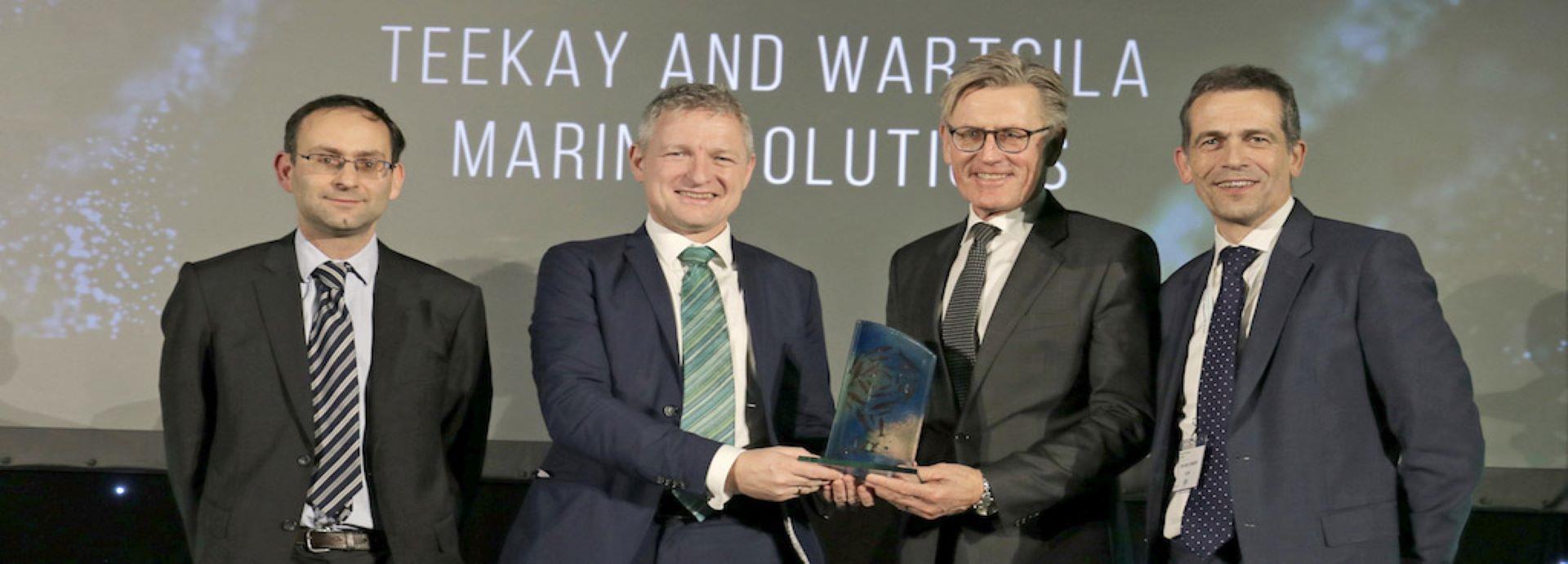

The E-Shuttle Tanker, jointly developed by Wärtsilä and Teekay, won the ITOPF Environmental Award for the shuttle at the Tanker Shipping and Trade Conference held in London in November 2018. It is only the beginning for this revolutionary concept.
“We had a good feeling about our concept so I was definitely happy that we won,” says Stein Thorsager, Sales Director for Merchant and Gas Carriers at Wärtsilä Marine Business. “We used a broad collection of solutions to resolve economic and environmental challenges in an innovative way.”
The Tanker Shipping and Trade Conference is a two-day event which attracts over 150 attendees from around the world. The conference consists of a variety of sessions covering all aspects of the tanker industry, as well as industry awards.
“The readers of Tanker Shipping & Trade magazine made the nominations for the ITOPF Environmental Award,” explains Edwin Lampert, Head of Content at organiser Riviera Maritime Media. “A high-level panel of independent industry experts made a short list of the candidates. An online vote from the readers chose Teekay and Wärtsilä as the winner.”
Wanted: unprecedented environmental solutions
Teekay is one of the world’s largest marine energy transportation, storage and production companies. They needed a new type of shuttle tanker to transport oil from offshore fields to land-based terminals.
“Teekay had four main ambitions for their new shuttle tanker, which they called the four E’s: it had to be Effective, Efficient, Environmentally-friendly and Economically sustainable,” says Thorsager.
Wärtsilä and Teekay collaborated closely to develop solutions for the new tanker class, designed to operate in the strict regulatory environment of Norwegian waters.
“One of the main innovations is the emission capture system,” Thorsager explains. “Traditionally, the oil vapour in tanks is vented into the atmosphere. This vapor includes substances like methane and ethane. Methane can be up to 80 times worse than CO₂ emissions, so this is a massive impact on the environment. Our idea was to convert these gases into usable fuel for the vessel, creating a zero Volatile Organic Compounds (VOC) emission solution.”
Turning waste gas into valuable fuel
VOC is the environmentally harmful gas evaporating from oil cargo tanks. The Wärtsilä VOC system recovers and liquifies this gas, which is then mixed with LNG to be used in the gas engine.
“By changing from a 2-stroke propulsion engine to a 4-stroke dual-fuel engine to improve efficiency, we have the ability to use a mix of VOC and LNG as fuel,” Thorsager continues.
It is complicated to liquify all of the VOC gases, but the residual isn’t vented. Instead, the light compounds are used as fuel in the installed gas turbine to create energy for the vessel grid system. Nothing goes to waste.
“One loading of the shuttle tanker can create about 100 tonnes of fuel,” says Thorsager. “Up to 35% of the energy required for the vessel can now be supplied by turning waste gas into valuable fuel.”
Winning the environmental award
The dramatic result explains why the E-Shuttle won the ITOPF Environmental Award. The total CO2 emissions are reduced by 67%, NOx from engine exhaust is cut 87% and particles are slashed by more than 96%. VOC emissions are eliminated and SOx emissions are practically eliminated.
Teekay’s Joakim Haugen and Wärtsilä’s Thorsager accepted the award together, proving that even better solutions can be developed in a co-creation process.
“We all have a responsibility for reaching the environmental goals now recently reconfirmed under COP24 in Poland,” Thorsager says. “We are also closely engaged in fulfilling the vision set by IMO for GHG emissions with an aim to reduce total emissions from shipping by 50% in 2050.”
Industry moves to higher environmental standards
Four of the Teekay E-Shuttles are now under construction by Samsung Heavy Industries in South Korea. Other companies are also interested. AET Tankers has ordered two new shuttle tankers with Wärtsilä’s VOC recovery technology.
The industry is moving towards more robust environmental standards, but at an uneven pace. As the ITOPF Environmental Award was presented in London Thorsager took the opportunity to point out the UK and Norway differ to the extent of regulating the reduction of VOC emissions.
“Norway’s environmental regulations push us to develop better solutions,” he says. “I hope the UK sees the benefit of these environmental solutions and how they have a major positive impact on the environment. Governments should take direct action to get these solutions adopted.”
Did you like this? Subscribe to Insights updates!
Once every six weeks, you will get the top picks – the latest and the greatest pieces – from this Insights channel by email.


